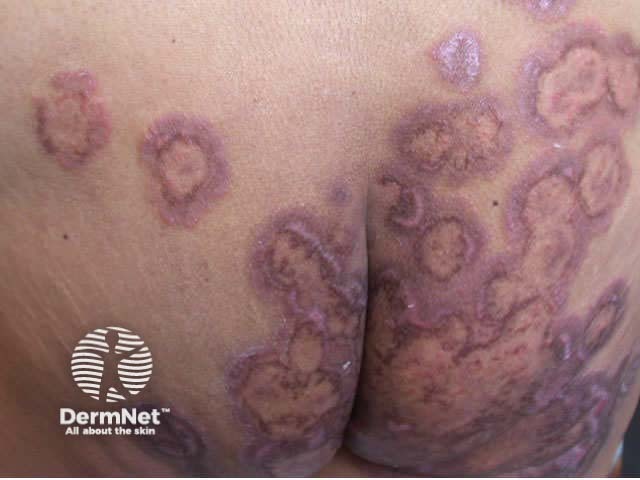Main menu
Common skin conditions

NEWS
Join DermNet PRO
Read more
Quick links
Tinea cruris
Created 2009.
Learning objectives
- Identify and manage tinea cruris
Clinical features
Tinea cruris refers to an acute, subacute or chronic groin infection with a dermatophyte fungus. It is most often seen in adult men. In New Zealand, T. rubrum and E. floccosum are the usual causes, spread from the feet or nails.
The rash has a scaly raised red border that spreads asymmetrically down the inner thighs from the inguinal folds or scrotum and is frequently very itchy. Tinea cruris may form ring-like patterns on the buttocks. It is not often seen on the penis or vulva or around the anus.
Tinea cruris Tinea cruris Tinea cruris Tinea cruris 



Management
First confirm the diagnosis (scrapings) and look for other sites of infection (feet, nails). Consider other reasons for intertrigo especially:
- Candida infection (acute onset, bright red skin, satellite pustules, peeling surface)
- Psoriasis (chronic, bright red, minimal symptoms, often signs elsewhere such as scalp, elbows, knees, flexures, nails)
- Erythrasma (chronic, dry, brownish, asymptomatic patches)
- Dermatitis (especially seborrhoeic, irritant contact, allergic contact variants)
Mild and localised tinea cruris can be managed with education and topical antifungal agents. Tell the patient to hot wash underwear and towels. They should be advised not to share towels and underwear. It is likely to recur, so suggest they dry carefully and apply an antifungal powder to feet and groin after bathing long term.
There are numerous topical antifungal agents, of which terbinafine cream (Lamisil™) is probably the most effective. However fully funded options in New Zealand (April 2005) are:
- Clotimazole cream
- Econazole cream
- Miconazole cream
Resistant culture-confirmed cases will require oral therapy for one to four weeks, usually terbinafine or itraconazole. Oral azoles require specialist approval for PHARMAC subsidy.
Activity
Tinea cruris is contagious. Consider the advice you would give a patient who asks about sexual transmission.
References:
On DermNet:
Information for patients
Other websites:
- Medscape Reference: Tinea cruris
- Merck Manual Professional: Dermatophytoses
Books about skin diseases:
See the DermNet bookstore
